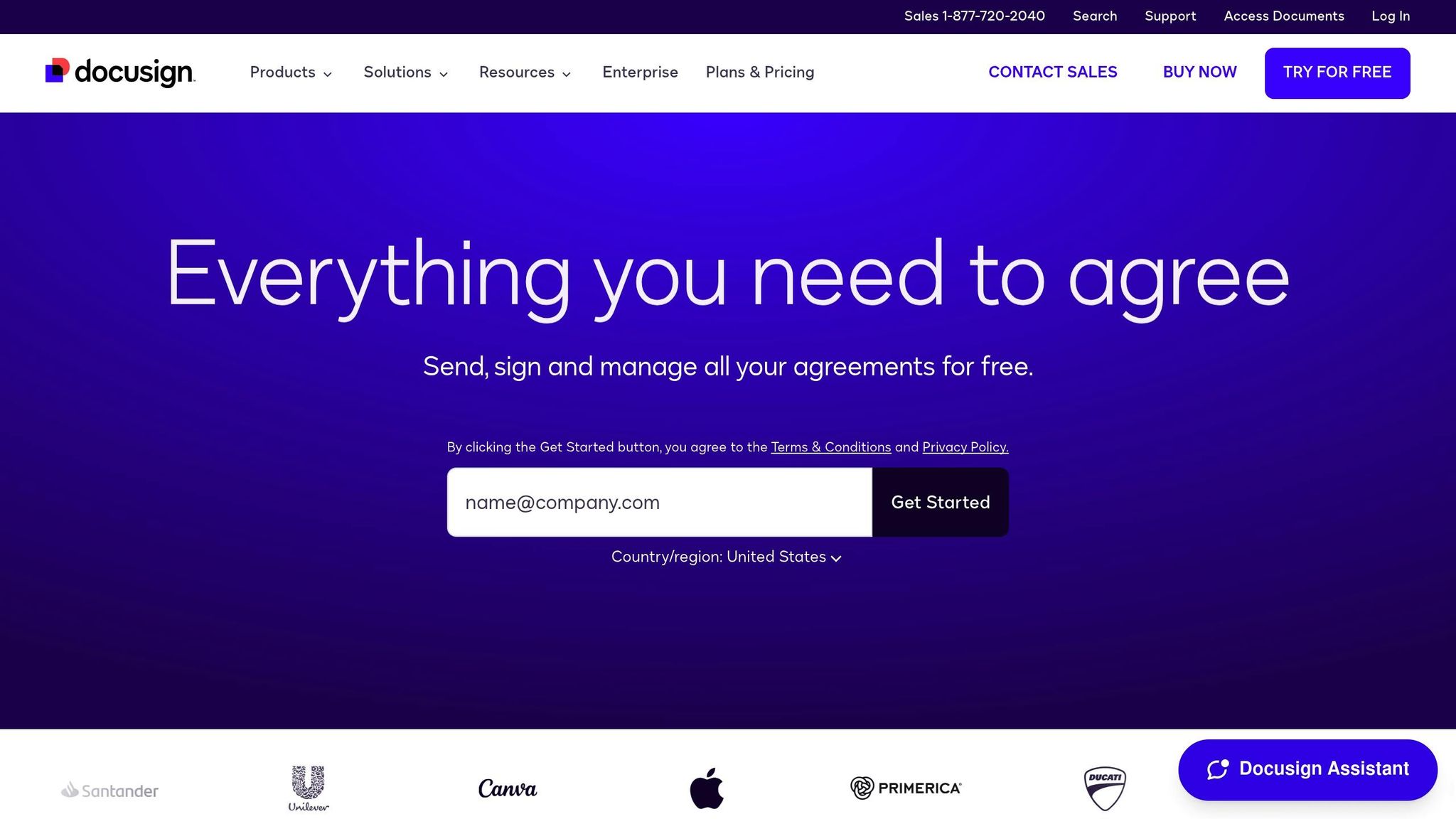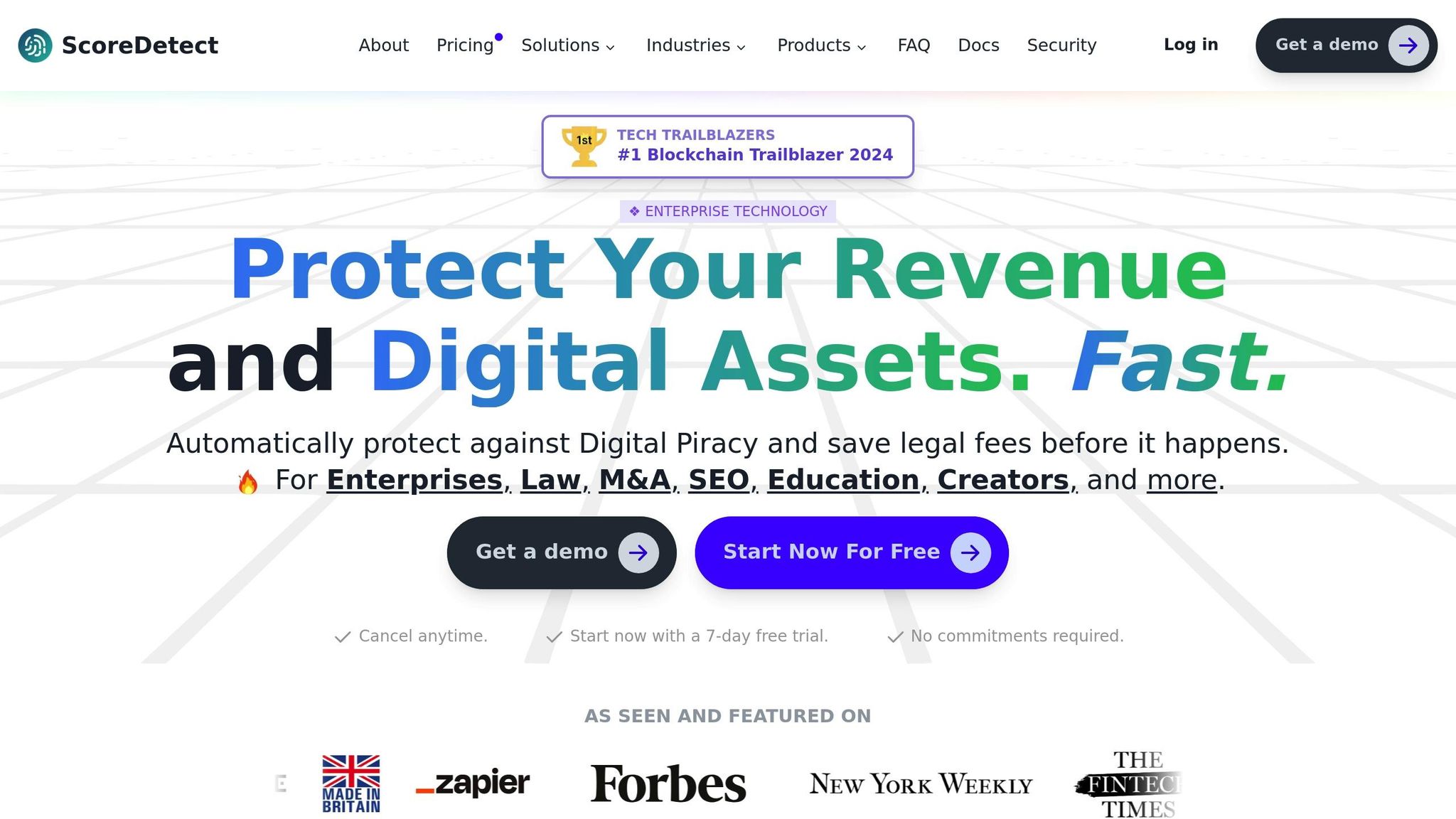Blockchain technology is reshaping how electronic signatures (eSignatures) meet legal and security requirements. Here’s what you need to know:
- eSignatures are legally valid under U.S. laws like the ESIGN Act and UETA, provided they meet key standards such as identity verification, document integrity, non-repudiation, and audit trails.
- Blockchain enhances security by creating tamper-proof records, using cryptographic tools to verify identities, and generating transparent audit trails.
- Regulatory compliance is critical for businesses, especially in industries like healthcare, finance, and legal services. Blockchain-based eSignatures align with these requirements, offering improved verification and fraud prevention.
- By 2025, regulations are stricter, focusing on data handling, cross-border compliance, and industry-specific standards, making blockchain a reliable tool for navigating these challenges.
Why It Matters
Blockchain’s ability to ensure document integrity, provide real-time verification, and maintain transparent records makes it a strong solution for businesses aiming to meet evolving regulatory demands while improving efficiency.
Read on to learn how blockchain integrates with eSignatures and why it’s becoming essential for compliance in today’s digital landscape.
Key Regulatory Standards for eSignatures in the U.S.
ESIGN Act and UETA Overview
The ESIGN Act of 2000 ensures that electronic signatures and records are legally valid across the United States. On the state level, the Uniform Electronic Transactions Act (UETA) complements this federal law by affirming the legality of eSignatures within most individual states. To date, UETA has been adopted by 49 states, along with the District of Columbia and the U.S. Virgin Islands. The exception is New York, which follows its own electronic signature legislation. This broad adoption provides a solid legal framework for using eSignatures in nearly all U.S. jurisdictions.
Both the ESIGN Act and UETA are technology-neutral, defining an electronic signature as “an electronic sound, symbol, or process attached to or logically associated with a contract or other record and executed or adopted by a person with the intent to sign the record.” Some states have even updated their laws to address emerging technologies. For instance, Nebraska explicitly recognizes blockchain-created contracts and records as electronic records under UETA, confirming the validity of blockchain-based eSignatures.
These laws form the foundation for compliance standards in the eSignature space.
Core Compliance Requirements
U.S. regulations for eSignatures revolve around four key principles:
- Identity Verification: The signer’s identity must be confirmed using reliable methods such as multifactor authentication or biometrics.
- Document Integrity: The signed document must remain unchanged, with any modifications easily detectable.
- Non-repudiation: There must be clear, verifiable evidence linking the signature to the signer.
- Audit Trails: Detailed records of the signing process – including timestamps, signer actions, and document status changes – must be maintained to serve as evidence in legal or regulatory scenarios.
Blockchain technology naturally supports these requirements through its core features, such as immutability, cryptographic security, and transparent audit trails with precise timestamps.
As regulatory landscapes shift, these compliance measures are being tested by new challenges in 2025.
New Regulatory Trends in 2025
By 2025, regulatory scrutiny of eSignature platforms has intensified. Authorities are focusing more on how these platforms handle sensitive data, particularly in light of stricter data protection and cybersecurity standards. Transparency and auditability are now under the microscope, with regulators demanding more comprehensive documentation of how eSignature systems operate – especially those incorporating blockchain and other advanced technologies.
Compliance is no longer a one-time task; businesses must now monitor regulatory changes continuously and adjust their processes to stay aligned. Navigating cross-jurisdictional compliance has also become more challenging, as subtle differences in how states implement UETA can complicate efforts to maintain uniform standards.
Industry-specific regulations are adding another layer of complexity. For example:
- Healthcare organizations must ensure eSignatures comply with HIPAA requirements.
- Financial services firms face heightened security demands to protect sensitive financial data.
- Government contractors often need to meet NIST guidelines and adhere to specific cryptographic requirements.
These evolving trends are reshaping how businesses approach eSignature compliance, requiring ongoing vigilance and adaptability.
Digital Signatures and Blockchain: How DocuSign Does It by Cyril Thirion

How Blockchain Meets Regulatory Standards
Blockchain technology aligns seamlessly with key U.S. compliance standards by utilizing its core features: immutable records, cryptographic security, and transparent verification. These properties naturally meet the requirements of the ESIGN Act and UETA, offering a more efficient alternative to traditional methods. Here’s a closer look at how blockchain satisfies U.S. regulatory demands.
Immutability and Audit Trails
Blockchain’s append-only ledger ensures that recorded signatures remain unchanged, directly meeting regulatory requirements for document integrity. This tamper-resistant structure creates a clear and unalterable record of every signature event, which is crucial for compliance with U.S. regulations.
In addition, blockchain automatically generates detailed, time-stamped audit trails. These records provide regulators with verifiable proof of compliance by documenting every action – such as who accessed the document, when changes occurred, and the specific sequence of signing events. This built-in auditability eliminates the need for manual tracking and bolsters confidence in the integrity of the process.
Cryptographic Security and Authentication
Advanced cryptographic algorithms form the backbone of blockchain security. Public-private key pairs ensure that only authorized individuals can sign documents, while each signature is uniquely tied to the signer, meeting legal standards for non-repudiation.
Blockchain also employs cryptographic hashing, which generates a unique digital fingerprint for each document. Any modification to the document causes a mismatch in the hash, immediately signaling tampering. This mechanism ensures document integrity and satisfies U.S. non-repudiation standards.
To meet stringent regulatory expectations, blockchain-based eSignature solutions incorporate industry-standard security protocols, including AES encryption, TLS protocols, ISO 27001 frameworks, FIPS 140-2 Level 2+, and X.509 certificates. These measures not only ensure robust authentication but also enable real-time verification – a critical feature discussed next.
Real-Time Verification and Transparency
Blockchain’s distributed ledger system allows for instant verification of digital signatures. Authorized parties can immediately confirm the authenticity and status of any signature by accessing the public ledger, eliminating delays and uncertainty.
This transparency enhances regulatory trust by ensuring that the validity of signatures and the history of documents remain accessible and tamper-proof. Publicly verifiable records also simplify dispute resolution by providing clear, indisputable evidence of all signature-related activities.
Platforms like ScoreDetect showcase this transparency by including blockchain transaction URLs in their verification certificates. These URLs offer publicly accessible proof of content timestamps and integrity. As the platform explains:
Real-time verification also streamlines regulatory audits and compliance checks. Instead of relying on documentation from multiple sources, auditors can directly access blockchain records to confirm the authenticity of signatures and the integrity of documents. This instant access not only simplifies audits but also strengthens regulatory confidence.
Moreover, blockchain’s transparency addresses challenges with cross-jurisdictional compliance. For example, varying state implementations of UETA, particularly as new trends emerge in 2025, can complicate compliance for businesses operating across states. Blockchain’s consistent and verifiable records help maintain uniform standards, making it easier for businesses to navigate differing regulations while ensuring compliance across multiple jurisdictions.
sbb-itb-738ac1e
Step-by-Step Guide to Using Blockchain for eSignatures
Using blockchain for eSignatures involves careful planning, especially when it comes to meeting regulatory requirements. Here’s a practical guide to help businesses adopt blockchain technology for digital signatures while staying compliant with U.S. laws.
Assess Legal and Industry Requirements
Before diving in, it’s crucial to evaluate the legal and industry-specific regulations that apply to your business. Different sectors often have unique compliance needs:
- Healthcare: Must align with HIPAA regulations.
- Financial institutions: Need to meet banking-specific standards.
- Legal firms: Often require stricter documentation protocols.
- Government contractors: May face additional federal oversight.
Consulting with legal experts is essential, particularly for complex or multi-state transactions. They can help pinpoint specific compliance needs and address cross-jurisdictional challenges. Staying updated on regulatory changes, especially as new trends emerge in 2025, is equally important.
Also, consider the types of documents you’ll be signing. For instance, high-value contracts, real estate deals, or regulatory filings often demand stronger security and detailed audit trails compared to everyday business agreements. Once you’ve outlined your compliance obligations, you’re ready to move forward with implementation.
Deploy Blockchain-Integrated Solutions
Choosing the right blockchain platform is key. Look for solutions that provide reliable audit trails, strong cryptographic security, and seamless integration with identity verification systems. It’s vital that your chosen platform complies with laws such as the ESIGN Act and UETA, along with any industry-specific regulations.
For example, ScoreDetect offers a blockchain integration that securely stores certificate data, enabling instant validation and tamper detection. This ensures compliance with ESIGN and UETA while boosting trust in digital transactions.
To avoid deployment issues, make sure your blockchain solution integrates smoothly with existing tools like document management systems, customer relationship management platforms, and workflow tools. Integration hiccups can lead to delays and even compliance risks.
Security is another critical factor. Implement multi-factor authentication (MFA) and use trusted identity providers to ensure each signature is tied to a verified individual. All verification steps should be logged on the blockchain for complete transparency and auditability.
ScoreDetect takes a privacy-focused approach by hashing digital content directly on the user’s device and storing only the checksum on the blockchain. This method ensures data authenticity while protecting sensitive information. As they explain:
"Your digital content is securely hashed on your device and is not saved anywhere else. Only the checksum of the digital content is saved, and placed into the blockchain."
Additionally, configure your system to record time-stamped audit trails for every signature event. These logs should track document access, changes, and the sequence of signing events. This not only ensures compliance but also makes audits much easier down the line.
Before rolling out the system fully, test it with low-risk documents. Piloting the workflow allows you to identify and address potential issues, ensuring everything runs smoothly for critical business processes.
Monitor Compliance and Security
Deploying the solution is just the beginning – ongoing monitoring is essential to maintain compliance and security. Regular security audits can help uncover vulnerabilities and ensure your system stays aligned with evolving regulations. Conduct these audits periodically or whenever significant changes are made to the system.
For example, in August 2025, ScoreDetect enhanced its platform by implementing MFA, strengthening user account security and reinforcing the importance of continuous updates.
Set up automated alerts to flag suspicious activity or unusual access patterns. Immediate notifications to your security team can help prevent potential breaches.
Keeping up with regulatory changes is also critical. Subscribe to legal updates, join industry groups, and maintain relationships with compliance experts. This proactive approach helps you avoid compliance gaps as laws evolve.
Documenting compliance activities is another must. Maintain detailed logs of security audits, system updates, training sessions, and policy changes. These records will serve as evidence of due diligence during regulatory inspections.
ScoreDetect simplifies monitoring with automated workflows via its Zapier integration, connecting with thousands of web apps to track and manage digital content authenticity. This reduces manual oversight while ensuring comprehensive compliance.
Finally, establish clear policies for managing verification certificates and blockchain records. Decide whether certificates should remain publicly accessible or be stored securely offline. For example, ScoreDetect certificates can play a key role in copyright protection, so handling them according to your organization’s legal and business needs is essential.
Regular employee training is equally important. Update training materials as regulations change and new threats emerge. A well-informed team is your first line of defense against compliance violations and security issues.
To stay ahead, budget for ongoing system updates, security improvements, and compliance monitoring. Blockchain technology is constantly evolving, and your eSignature solution must keep pace to remain effective and compliant.
Case Study: Blockchain Content Authentication with ScoreDetect

ScoreDetect provides a compelling example of how blockchain technology can be applied to authenticate content while ensuring compliance with U.S. regulatory standards. By leveraging blockchain’s ability to create secure, transparent, and tamper-proof records, ScoreDetect demonstrates how digital signatures and content protection can meet legal requirements without compromising security.
This case study focuses on three key mechanisms that ScoreDetect employs: timestamping, workflow automation, and legal verification.
Blockchain Timestamping for Copyright Protection
At the heart of ScoreDetect’s approach is blockchain timestamping, which establishes undeniable proof of ownership. The platform achieves this by generating a unique cryptographic checksum for each digital asset and recording it on the blockchain with a timestamp. This process creates an unalterable record of ownership.
This method aligns with the ESIGN Act and UETA by producing tamper-proof, time-stamped records that are legally recognized as evidence. To strengthen its legal applicability, ScoreDetect issues verification certificates that include the content’s checksum, a blockchain transaction URL, and multiple verification methods. These certificates act as formal evidence, providing an additional layer of credibility in legal settings through publicly accessible and immutable records.
Automated Compliance Workflows
ScoreDetect also simplifies compliance through automated workflows that ensure ongoing protection and auditability. For instance, its WordPress plugin automatically captures every article that is published or updated, creating a blockchain-based proof of ownership for each piece of content. This automation eliminates the need for manual intervention, reducing the risk of human error and ensuring consistent compliance.
This feature is particularly beneficial for industries like healthcare, finance, and legal services, where maintaining detailed documentation and audit trails is crucial for adhering to regulations. By automating these processes, ScoreDetect not only saves time but also ensures that compliance gaps are minimized.
Supporting Legal Admissibility and Transparency
Another critical aspect of ScoreDetect’s platform is its focus on legal credibility. The platform generates formal certificates that include official signatures, technical details, and blockchain-verified timestamps, bolstering their use as admissible evidence in legal contexts.
Additionally, ScoreDetect’s audit trail functionality records every interaction with protected content, creating a clear chain of custody backed by blockchain-verified timestamps. This tamper-evident documentation aligns with U.S. legal requirements for audits and disclosures, ensuring transparency in every step of the process.
To further enhance trust, ScoreDetect offers public verification methods, allowing third parties to independently confirm the integrity and timestamps of protected content. While the legal weight of these records may vary by jurisdiction, they serve as valuable supporting evidence when combined with other safeguards, adhering to best practices for regulatory compliance.
For organizations looking to implement blockchain-based content authentication, ScoreDetect provides a practical blueprint. Its approach balances the need for technical security with the demands of regulatory compliance, offering robust audit trails and immutable records while maintaining operational efficiency. This ensures alignment with U.S. electronic signature and digital record standards, making it a reliable solution for businesses in regulated sectors.
The Future of Blockchain and eSignatures
The combination of blockchain technology and electronic signatures is transforming the way digital transactions are handled, particularly when it comes to compliance. As more organizations prioritize secure and transparent digital processes, blockchain-based solutions are emerging as a reliable standard for electronic signature compliance. Here’s a closer look at the key advantages and what lies ahead.
Key Takeaways
Blockchain technology strengthens eSignature compliance in three main ways: immutability, cryptographic security, and real-time verification. These features align closely with U.S. regulations like the ESIGN Act and UETA, ensuring that electronic signatures not only meet legal standards but also provide robust protection against fraud and tampering.
- Immutable audit trails: Blockchain creates tamper-proof records that verify document authenticity and signer identity, offering a level of reliability that centralized systems often can’t match.
- Eco-friendly advancements: New blockchain innovations are reducing operational costs while automated workflows streamline the signature process. These workflows capture, timestamp, and verify signatures automatically, minimizing the need for manual intervention.
Looking Ahead
Blockchain’s potential to enhance eSignature compliance is far from fully realized. Future developments will likely integrate regulatory compliance more seamlessly with technological innovation.
- Advanced smart contracts: These will enable automated compliance checks, sending alerts for regulatory updates or deviations from required processes. This proactive approach helps organizations adapt quickly to changing regulations.
- Interoperable blockchain networks: Cross-border transactions remain a challenge in international commerce. Interoperable networks could simplify global compliance, allowing businesses to meet regulatory standards across multiple jurisdictions at once.
- AI-driven monitoring: Pairing blockchain with artificial intelligence will introduce real-time risk assessments, flagging potential compliance issues early. It will also improve fraud detection and prevention systems.
- Enhanced privacy features: New blockchain designs will focus on protecting sensitive information while maintaining the transparency needed for regulatory compliance. This will be especially important for industries like healthcare and finance, where data confidentiality is critical.
Industry leaders are already recognizing the value of these advancements. For example:
"ScoreDetect is exactly what you need to protect your intellectual property in this age of hyper-digitization. Truly an innovative product, I highly recommend it!" – Imri, Startup SaaS CEO [1]
The regulatory environment is also evolving to support blockchain technology. Existing laws like ESIGN and UETA, which are technology-neutral, provide a strong foundation for blockchain adoption. New guidelines are expected to address emerging challenges such as data privacy, cross-jurisdictional compliance, and real-time verification.
As blockchain continues to mature, its adoption across regulated industries is likely to grow. The need for greater security, transparency, and compliance will drive this trend, along with the added benefits of lower costs and improved efficiency. Blockchain-based eSignatures are well-positioned to play a central role in the future of digital transactions.
FAQs
How does blockchain improve the security and reliability of eSignatures compared to traditional methods?
Blockchain technology takes the security and reliability of eSignatures to the next level by establishing an unchangeable digital record of every signing event. Each signature is linked to a distinct cryptographic checksum, which means any tampering with the document can be immediately identified.
Rather than storing the actual digital files, blockchain creates a verifiable record that proves both ownership and authenticity. This approach provides a highly secure and transparent way to comply with regulatory requirements.
What regulatory challenges could businesses face with eSignatures by 2025, and how can blockchain help solve them?
By 2025, businesses could face tougher regulatory hurdles when it comes to eSignatures. Stricter data privacy laws, tighter security requirements, and shifting legal standards are likely to raise the bar for ensuring the authenticity and integrity of digital signatures, adding complexity to compliance efforts.
Blockchain technology steps in as a game-changer here. It creates a tamper-proof and transparent record of eSignatures, making every signature both secure and easy to verify. This significantly cuts down the risk of fraud and helps meet regulatory demands. On top of that, tools like ScoreDetect use blockchain to provide undeniable proof of ownership for digital content, boosting trust and reinforcing legal reliability.
How can blockchain-based eSignatures be integrated with existing systems to meet regulatory requirements?
Blockchain-based eSignatures bring a new level of security and compliance to digital transactions by integrating smoothly with existing systems. Their core strength lies in creating secure, unchangeable records. By storing a unique digital fingerprint (checksum) of signed documents on the blockchain, they provide undeniable proof of both authenticity and integrity – without ever revealing sensitive information.
Tools such as ScoreDetect take this a step further. By leveraging blockchain technology, they generate tamper-proof records of digital assets. This not only ensures adherence to industry regulations but also protects intellectual property and builds trust in both legal and business operations.

